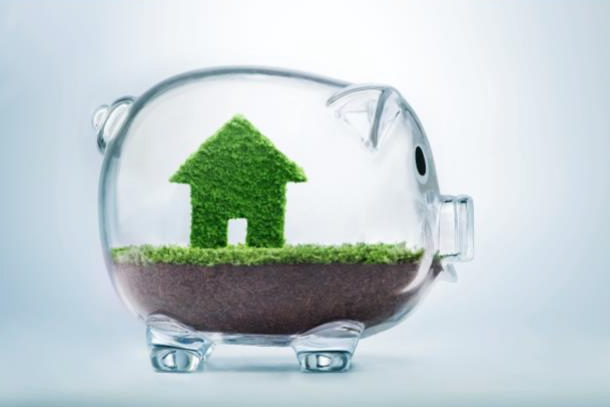By Michele DiGirolamo, Guest Contributor from MoneyGeek.com
If you’re in the market for a new home, there’s a way to save the environment and some cash at the same time: Consider a “green” mortgage.
An energy-efficient mortgage (EEM), the umbrella term for these types of loans, allows buyers to fold expenses for energy-saving home improvements into their mortgage.
EEMs are an option if you’re buying or building a home and you want to add energy-efficient features, if you’re refinancing a mortgage for a home you already own and want to add energy-efficient renovations, or if you’re buying a new home that is already energy-efficient.
The idea is that, in the long run, the money saved on monthly utility bills will offset the higher mortgage payment. The projected energy savings from the lower bills could also qualify buyers for a larger loan amount and a better, more energy-efficient home.
And at the point of resale, homeowners will likely benefit again, as the energy upgrades can boost the home’s value and attract buyers in a competitive market.
Improving Your Home’s Energy Efficiency
Green mortgages can be used to finance a range of energy-efficient upgrades, from weather stripping to new heating and cooling systems to double-pane windows and solar panels.
A required home energy audit provides recommendations for energy-saving improvements and estimates of the costs and savings of those improvements. Lenders use this information to determine how much you’ll save in energy costs with each improvement.
Fannie Mae, the Federal Housing Administration, and the Department of Veterans Affairs all offer a version of EEMs. The amount of energy improvements a borrower can finance varies by program, ranging from about 5 percent of the value of the property through an FHA loan to around 15 percent with a conventional mortgage. A VA EEM, available to military personnel, caps energy improvements at $3,000 to $6,000.
Understanding the Green Mortgage Lending Process
While securing an EEM can be fairly simple for the borrower, it can be cumbersome for lenders unaccustomed to the process of managing the “work flow” of the energy improvements, says Tonya Todd, senior vice president of strategic products at Mountain West Financial in Redlands, California. This may be why they aren’t more common.
“The loan itself is easy; it’s the facilitation that takes some work,” Todd says. “Lenders that are successful at this will find a local energy-efficient mortgage facilitator. The facilitator handles everything from A to Z to ensure a smooth and timely process for all parties.”
The facilitator works with the buyer, the energy rater, the contractor, the realtor and the lender to keep everything moving to avoid delays.
“After closing, the facilitator will ensure the installation of the energy improvements are completed,” she adds. “It just makes everything much smoother.”
So, if you’re interested in pursuing an EEM, go for it — just be aware you may have to put some effort into finding a lender.
“Niche lenders do offer these programs and do them well,” Todd says. “However, a lot of lenders do not offer them because they do not understand the operational component, or they don’t have the support system internally.”
More Homeowners Are Going Green
While they’ve been around in some form since the 1990s, eco-friendly mortgages even today are not particularly well-known. But that could be changing, Todd says.
“Energy-efficient measures are becoming more popular especially as homeowners are purchasing older homes that may not be so environmentally friendly,” Todd adds. “People are more aware of being green. That’s why homeowners are looking for features that will help them save energy.”
The average household spends more than $2,200 a year on energy bills, with nearly half of that going to heating and cooling costs, according to the U.S. Department of Environmental Protection’s Energy Star program. There are significant savings to be had by improving a home’s energy efficiency.
Other Ways to ‘Green’ Your Home
Even if you’re not in the market for a green mortgage, there are measures you can take around your house to save energy and reduce your utility bills. The following are some tips — some simple, some more involved — from the Energy Star program and other experts:
- Turn your hot water heater’s thermostat to 120 degrees Fahrenheit.
- Keep your refrigerator at 37-40 degrees and freezer at 5 degrees.
- Install and properly use a programmable thermostat (this can save about $180 annually).
- Install low-flow fixtures.
- Do only full loads in the washer and dishwasher.
- Fix any leaky faucets, toilets, pipes, and your roof.
- Seal heating and cooling ducts (in the typical house, about 20 percent of the air in a duct system is lost due to leaks, holes, and poorly connected ducts).
- Seal the “envelope” of your home – the outer walls, ceiling, windows, and floor (this can save 20 percent on heating and cooling costs).
- Replace the filters on your air conditioning unit, dryer, and furnace.
- Turn off ceiling fans when you’re not home.
- Set ceiling fans counter-clockwise in the summer to draw cooler air upward.
- Dust your refrigerator coils.
- Plant shade trees to cool your home.
- Request a home energy audit for more tips and advice.
ABOUT THE AUTHOR: Michele DiGirolamo is a former longtime reporter for United Press International and a freelance writer for MoneyGeek.com.
[ad_2]
Source link

